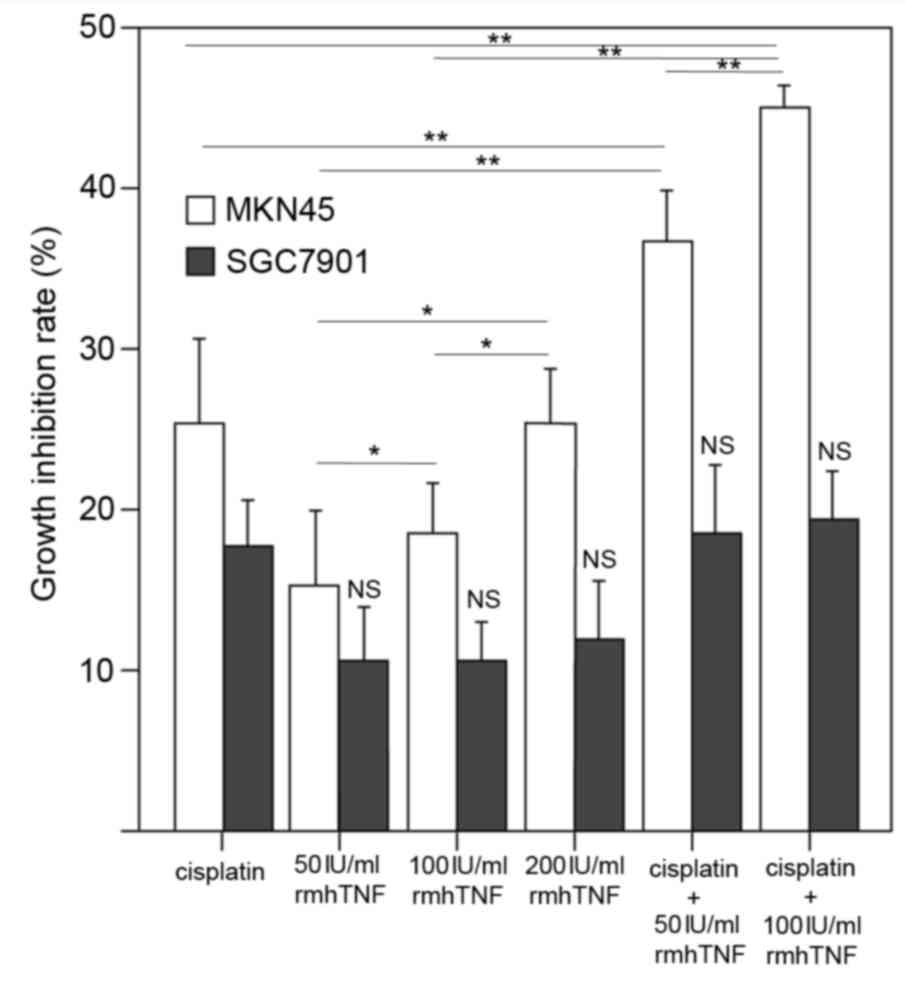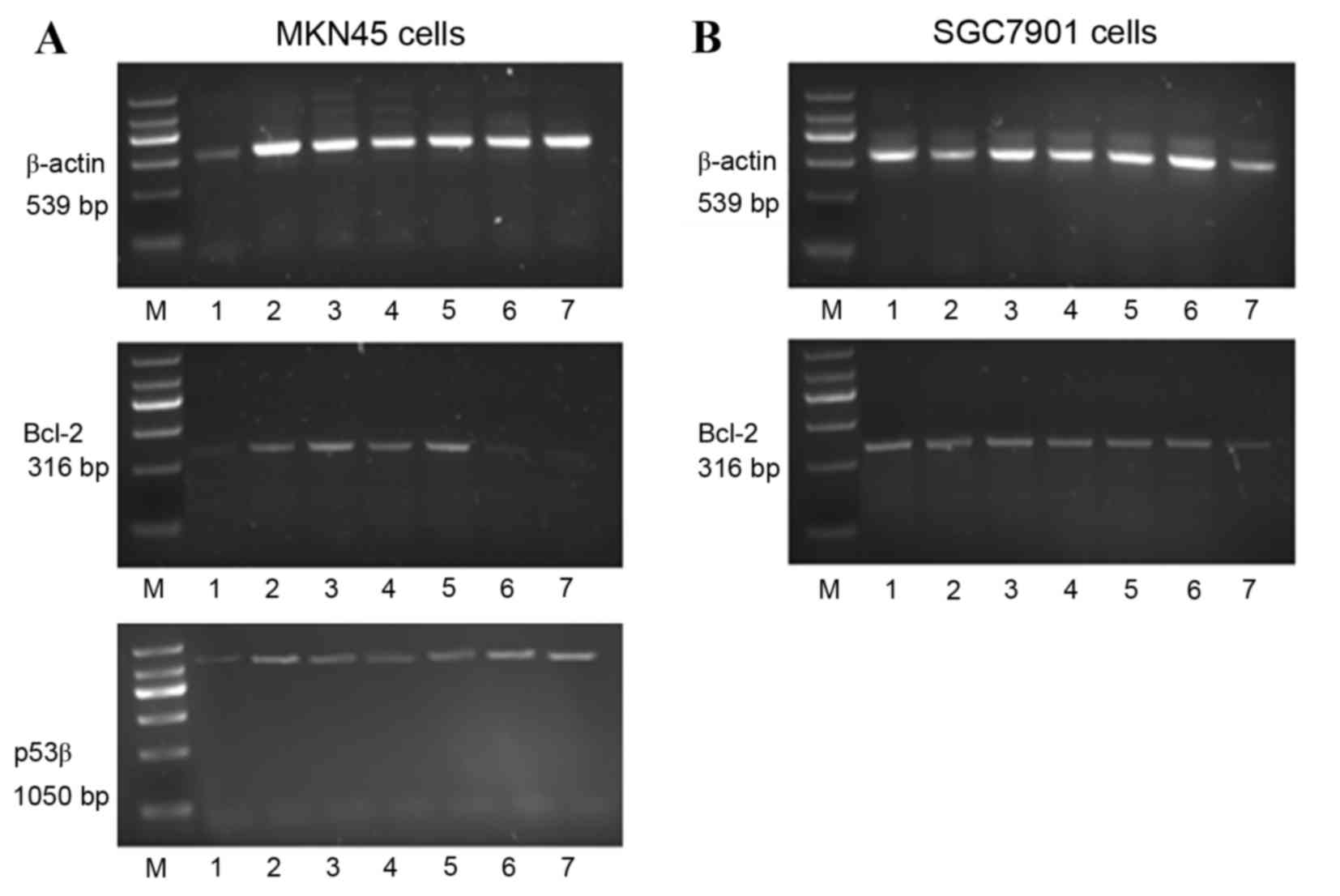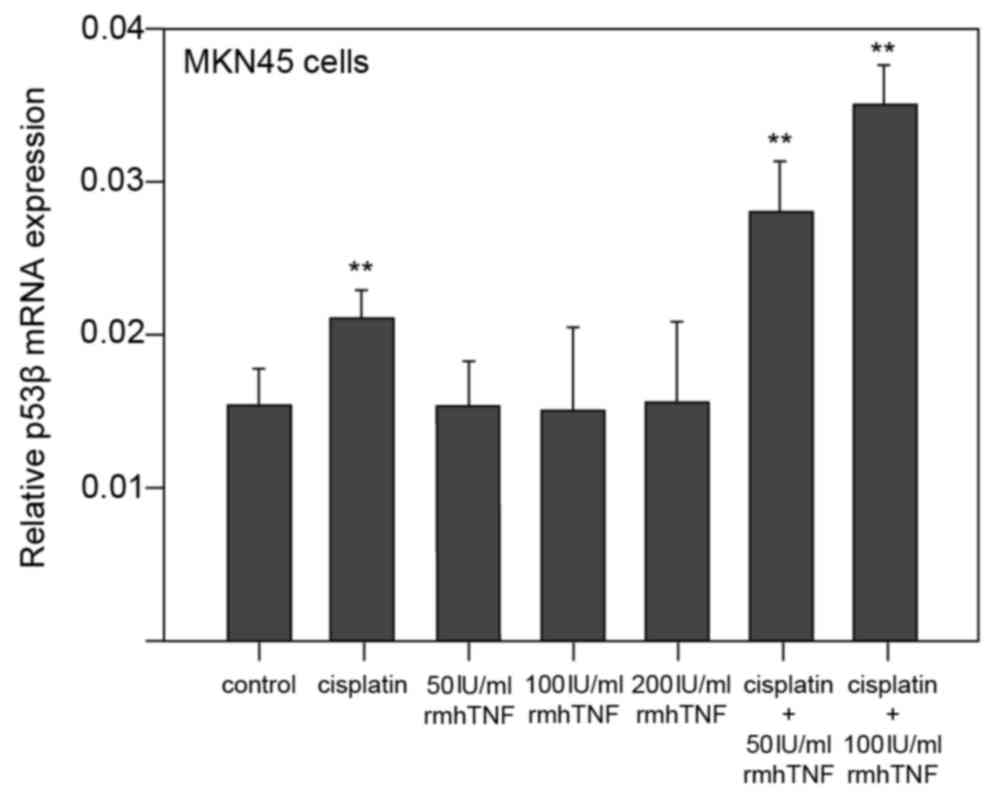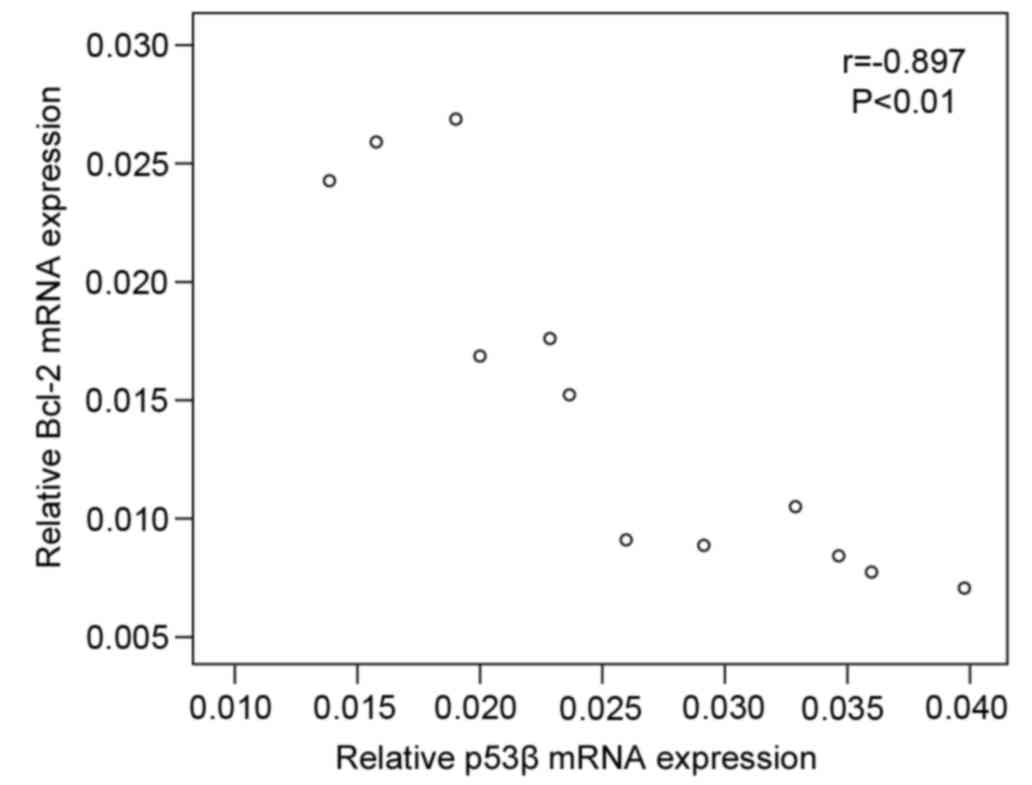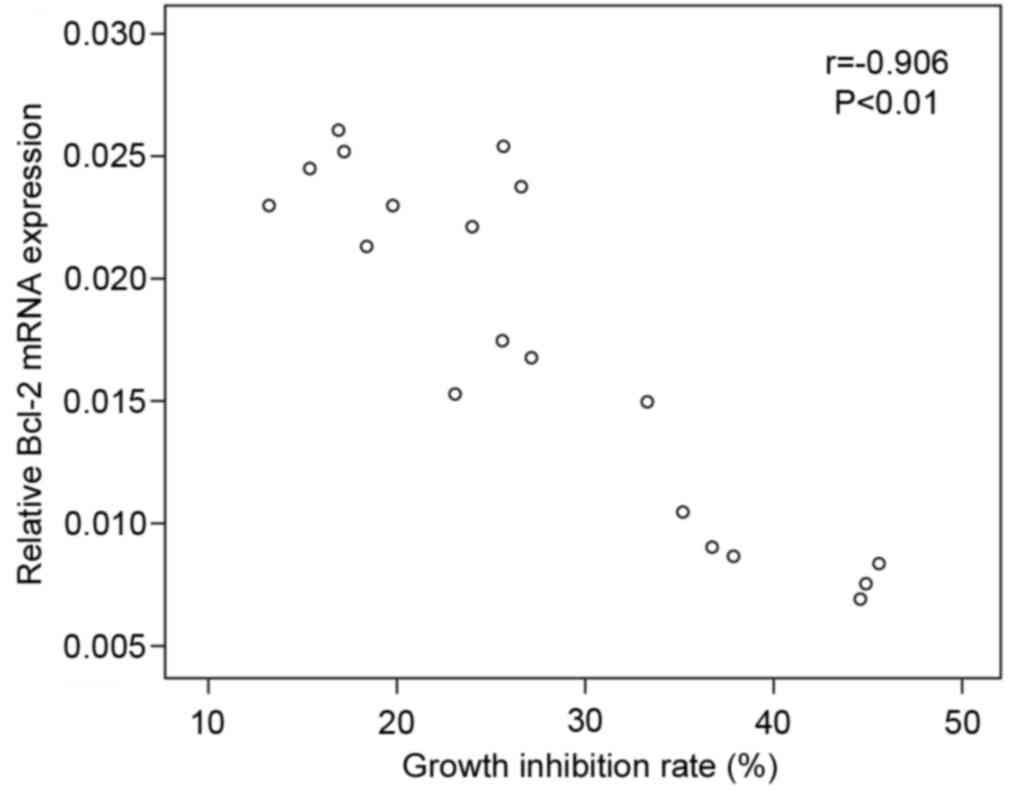Effect of p53β on human gastric cancer cells treated with recombinant mutated human TNF and cisplatin
- Authors:
- Published online on: April 4, 2017 https://doi.org/10.3892/mmr.2017.6436
- Pages: 3865-3870
Abstract
Introduction
Gastric cancer (GC) is associated with high mortality worldwide, but its occurrence is particularly high in China and other Asian countries (1,2). Many patients are diagnosed in the late stages of GC, and thus cannot undergo surgery and are subjected to chemotherapy instead. However, the efficacy of 5-fluorouracil- and cisplatin-based regimens during the late stages of GC is limited (3,4). Currently, the prognosis for GC patients is very poor; thus, novel therapeutic targets and alternative treatment strategies are urgently required.
Tumour protein 53 (p53) was first described in 1979 (5), as a protein that bound to the simian virus large T antigen. Inactivation of p53 is evident in more than half of all human cancers (6), and it is caused by mutations or deletions in the TP53 gene itself (7,8) or by changes in alternative splicing (9–11). Different isoforms of p53 are expressed in different tissues, including various types of normal, precancerous and malignant tissues (12–14). Previous results have linked several factors, including the presence of Helicobacter pylori infection, chronic gastritis, and p53 isoforms, with the occurrence of GC (15,16).
Tumour necrosis factor-α (TNF-α) is a potential anticancer agent, effective against various malignant tumours. The therapeutic benefit from TNF-α can be ascribed to its anti-proliferative effects, and its ability to increase the penetration of chemotherapeutic agents into tumour tissues (17). An increasing body of evidence suggests that recombinant mutated human TNF (rmhTNF) acts synergistically with traditional chemotherapeutic drugs to exert enhanced antitumor effects (18). Recently, rmhTNF has been administered to patients with non-small cell lung cancer, non-Hodgkin lymphoma, or malignant pleura and ascites, when other therapies failed (19). In the present study, the effects of combination treatment of the commonly used cytotoxic agent cisplatin and the novel agent rmhTNF were examined on two GC cell lines expressing either wild type or mutated p53 isoform β (p53β).
Materials and methods
Cells
The SGC-7901 (expressing mutant p53) and the MKN45 (expressing wild-type p53) GC cell lines were obtained from the Central Laboratory of Weifang Medical College (Weifang, China). Cell lines were passaged four times prior to harvesting for RNA isolation. All human cell lines were cultured in RPMI-1640 medium (Thermo Fisher Scientific, Inc., Waltham, MA, USA) with 5% foetal bovine serum (FBS; Thermo Fisher Scientific, Inc.) at 37°C/5% CO2.
Inhibition of cell growth
MKN-45 and SGC-7901 cells were seeded in 96-well plates at a density of 5×104 cells/ml and incubated at 37°C/5% CO2 for 24 h, in order to achieve the exponential phase of cell growth. The supernatant was then discarded, and fresh culture medium was added to the wells. Treatments were performed by adding to the culture medium the following: i) 4 µg/ml cisplatin (Deyao Pharmaceutical Co., Ltd., Dezhou, China); ii) 50 IU/ml rmhTNF (Shanghai Weike Biopharmaceutical Co., Ltd., Shanghai, China); iii) 100 IU/ml rmhTNF; iv) 200 IU/ml rmhTNF; v) 4 µg/ml cisplatin and 50 IU/ml rmhTNF; and vi) 4 µg/ml cisplatin and 100 IU/ml rmhTNF. Control wells contained medium alone (untreated cells). Following culture for 24 h at 37°C/5% CO2, the medium was replaced with 110 µl10% Cell Counting Kit-8 medium (Yesen Biotechnology Scientific Inc., Shanghai, China), and cells were incubated for another 2 h at 37°C/5% CO2. The absorbance at 450 nm (A450) was determined using a Bio-Tek PowerWave XS microplate reader (Bio-Rad Laboratories Inc., Hercules, CA, USA). The mean absorbance values were determined from four wells for each treatment group, and the growth inhibition rate was calculated using the following formula:
IC=(AExp–AC)(AC–AEmp)x100IC denotes the growth inhibition rate (%), AExp the mean absorbance for the treatment group, AC the mean absorbance for the control group, and AEmp the mean absorbance for wells without cells or reagents added.
Reverse transcription-polymerase chain reaction (RT-PCR)
4×104 MKN45 and SGC7901 cells in the exponential phase of growth were seeded in per well in 6-well plates and cultured for 24 h in medium supplemented with 4 µg/ml cisplatin, 50 U/ml rmhTNF, 100 U/ml rmhTNF, 200 U/ml rmhTNF, 4 µg/ml cisplatin and 50 U/ml rmhTNF, or 4 µg/ml cisplatin and 100 U/ml rmhTNF. As a control, normal growth medium without supplements was used (untreated cells). TRIzol® RNA isolation, M-MuLV first-chain synthesis and PCR amplification kits were all bought from Shanghai Sangon Biotech Corporation Ltd. (Shanghai, China). The concentration of total RNA in each sample was determined with a 2000c UV-Vis spectrophotometer (Thermo Fisher Scientific, Inc.). Each 20 µl reverse transcription reaction contained 4 µl 25 mM MgCl2, 2 µl 10xPCR Buffer II, 1 µl double-distilled water, 8 µl premixed deoxyribonucleoside triphosphates, 1 µl RNA inhibitor solution (20 U/µl), 1 µl random hexamers, 1 µl MuLV reverse transcriptase, and 2 µl total RNA (≤1 µg), as per the kit's protocols (Shanghai Sangon Biotech Corporation Ltd.). Total RNA was added just prior to the start of the reaction. Reactions were incubated at 25°C for 10 min, then at 42°C for 30 min, followed by 95°C for 5 min and then cooled at 5°C for 5 min. Samples were then diluted 1:4 to obtain a final concentration of 10 ng/µl cDNA. The PCR step was carried out on a PE-5700 MyCycler (Applied Biosystems; Thermo Fisher Scientific, Inc.) and involved 35 amplification cycles at 94°C for 1 min, 58°C for 50 sec and 72°C for 1 min. Specific oligonucleotide primers were used as listed in Table I. Amplicons were subjected to 1% (w/v) agarose gel electrophoresis, and gels were analysed with a BioSpectrum AC Gel Imaging System (Alpha Innotech Corp., San Leandro, CA, USA). The relative expression levels of target genes were calculated using the following formula:
Relativegeneexpression=AbsorbanceintegralareaoftargetgeneAbsorbanceintegralareaofβ–actinStatistical analysis
SPSS 20.0 (IBM SPSS, Armonk, NY, USA) was used in order to analyse experimental data, with values presented as the mean ± standard deviation. The difference among groups was assessed by one-way analysis of variance. Comparisons between two groups were conducted using the Student-Newman-Keuls method or Student's t-test. The relationship between two variables was analysed using Pearson's correlation coefficient. P<0.05 was considered to indicate a statistically significant difference.
Results
Effects of cisplatin and rmhTNF on GC cell growth
Following treatment with rmhTNF for 24 h, a significant inhibition of cell growth was observed in MKN45 cells in a dose-dependent manner (P<0.05; Fig. 1). However, no significant effect was observed on the cell growth of the mutant p53-expressing SGC7901 cells with rmhTNF treatment (Fig. 1). Combination treatment of cisplatin and rmhTNF acted synergistically to further enhance the inhibitory effect on the growth of MKN45 cells, compared with either cisplatin or rmhTNF treatments alone (P<0.01; Fig. 1). A synergistic effect of cisplatin and rmhTNF was not observed in the mutant p53-expressing SGC7901 cells (Fig. 1). The combination treatment of cisplatin was performed with two different doses of rmhTNF (50 and 100 IU/ml) and the growth inhibition observed was dose-dependent in MKN45 cells (P<0.01; Fig. 1).
Expression levels of p53β and bcl-2 apoptosis regulator (bcl-2) mRNA in GC cells
The mRNA expression of bcl-2 and p53β in MKN45 cells (Fig. 2A) and bcl-2 in SGC7901 cells (Fig. 2B) were determined. In MKN45 cells, p53β mRNA expression levels were significantly increased by cisplatin alone compared with untreated cells (P<0.01; Figs. 2A and 3). Treatment of MKN45 cells with rmhTNF alone had no effect on p53β mRNA expression compared with untreated cells (Figs. 2A and 3). However, when cisplatin was used in combination with rmhTNF, p53β mRNA expression levels were further increased compared with cells treated with cisplatin alone (P<0.01; Figs. 2A and 3), suggesting again that rmhTNF and cisplatin act synergistically in MKN45 GC cells.
In MKN45 cells, bcl-2 mRNA expression levels were significantly downregulated by cisplatin alone, or by combined cisplatin and rmhTNF treatment, compared with untreated cells (P<0.01; Figs. 2A and 4). However, no significant effect on bcl-2 mRNA expression levels was detected with rmhTNF treatment alone in MKN45 cells, compared with untreated cells (P>0.05; Figs. 2A and 4). In the mutant p53-expressing SGC7901 cells, bcl-2 mRNA levels were not significantly altered in either of the various treatment groups (P>0.05; Figs. 2B and 4).
Correlation between p53β and bcl-2 mRNA expression levels in MKN45 cells
Correlation analysis was performed to assess whether bcl-2 and p53β mRNA expression are associated with each other and with the growth inhibition phenotype. The results indicated that bcl-2 mRNA expression in MKN45 cells was negatively correlated with mRNA expression of p53β (r=−0.897; P<0.01; Fig. 5), and negatively correlated with the cell growth inhibition rate (r=−0.906; P<0.01; Fig. 6).
Discussion
Novel therapeutic targets and alternative therapies are urgently required to improve the prognosis of invasive GC. For more effective therapies, a prerequisite may be that the target of choice is commonly involved in GC. The p53 protein has suppressive effects in tumours, and p53 gene alterations are widespread in cancer (7,8,20–22). Although mutated forms of p53 are common in GC tissues, their pharmacological significance remains unclear. Previous results indicated that p53 isoforms and infection with H. pylori have a strong association with the development of GC (13). In a previous small-scale study (23), p53β downregulation and Δ133p53 upregulation was associated with superficial gastritis, atrophic gastritis, paracancerous areas, and eventually invasive GC. These findings indicated that p53 isoforms are involved in gastric carcinogenesis and could be potential targets for GC therapies.
The different p53 isoforms exhibit varying levels of prognostic significance in various cancer types, including breast (24,25) and ovarian (26–28) cancer. It remains unknown whether any of these isoforms could be used as actual targets for therapeutic development. The present study was designed to investigate the role of p53β in two GC cell lines with differing p53 status, that were treated with cisplatin and/or rmhTNF. The MKN45 GC cell line expresses wild-type p53 (29), while the SGC7901 cell line expresses a mutated form of p53 (GAG→GCG in exon six, corresponding to Glu→Ala in codon 204; (30). The growth of MKN45 cells was inhibited by rmhTNF alone, while the growth of SGC7901 cells was unaffected by rmhTNF. The inhibitory effect of cisplatin on the growth of MKN45 cells was enhanced by rmhTNF; however, this was not observed in SGC7901 cells. RT-PCR analysis revealed that cisplatin alone, but not rmhTNF, resulted in significant upregulation of p53β and downregulation of bcl-2 mRNA expression in MKN45 cells. The effect of cisplatin on p53β and bcl-2 mRNA expression was significantly enhanced by rmhTNF.
Taken together, the present study indicated that p53β serves a role in the inhibitory effects exerted by cisplatin on MKN45 GC cells, suggesting that p53β is a key target of cisplatin. Members of the bcl-2 family, which are downstream of p53 signalling, exhibit pro- or anti-apoptotic activity. The final action of bcl-2 family members is determined by the ratio of these mutually antagonistic members (31,32). It is currently unclear how p53β regulates expression of bcl-2 and other downstream targets of p53. One possibility is that tetramers with wild-type p53 are formed (33,34). In wild-type p53-negative H1299 cells, p53β is important in sensitizing these cells to chemotherapy (35). The precise function of p53β requires further clarification; however, the therapeutic significance of this p53 isoform is evident by its negative correlation to breast tumour size, and its positive association with disease-free survival periods (36,37). In the present study, bcl-2 expression was negatively correlated with p53β expression in MKN45 cells, which contain wild-type p53. This was not observed in SGC7901 cells, which contain a mutated form of p53, thereby indicating a p53-dependent mechanism for cisplatin.
The present study indicated that rmhTNF is not able to exert its effects on the p53β-bcl-2 pathway directly, but only when in combination with cisplatin. rmhTNF may function as an enhancer, improving the effects of cisplatin on the inhibition of cellular growth, upregulation of p53β, and downregulation of bcl-2, through mechanisms that are yet to be elucidated. Previous findings revealed that Δ133p53 is involved in the progression from chronic gastric inflammation to carcinoma (15,38–40). An association between Δ133p53, rmhTNF, and treatment of gastric carcinoma is evident, but further investigations are required to clarify this. In addition, further work is required to screen for targets of rmhTNF and to determine whether Δ133p53 is a target of rmhTNF. Determining the genotype or phenotype that is most closely associated with rmhTNF may improve drug regimens against GC.
In summary, the present study indicated that p53β is involved in the cisplatin-mediated growth inhibition of MKN45 GC cells. The effects of cisplatin on these cells were enhanced when combined with rmhTNF. The mechanism of action for the synergistic effect of cisplatin and rmhTNF remains unknown; however, the present study indicated that p53β may be a critical target in the pharmacology of GC.
Acknowledgements
The present study was supported by Shandong Provincial Award Foundation for Youth and Middle-aged Scientist (grant no. BS2010SW034).
References
|
Parkin DM, Bray F, Ferlay J and Pisani P: Global cancer statistics, 2002. CA Cancer J Clin. 55:74–108. 2005. View Article : Google Scholar : PubMed/NCBI | |
|
Jemal A, Bray F, Center MM, Ferlay J, Ward E and Forman D: Global cancer statistics. CA Cancer J Clin. 61:69–90. 2011. View Article : Google Scholar : PubMed/NCBI | |
|
Schirren R, Reim D and Novotny AR: Adjuvant and/or neoadjuvant therapy for gastric cancer cancer? A perspective review. Ther Adv Med Oncol. 7:39–48. 2015. View Article : Google Scholar : PubMed/NCBI | |
|
Ito S, Oki E, Nakashima Y, Ando K, Hiyoshi Y, Ohgaki K, Saeki H, Morita M, Sakaguchi Y and Maehara Y: Clinical significance of adjuvant surgery following chemotherapy for patients with initially unresectable stage IV gastric cancer. Anticancer Res. 35:401–406. 2015.PubMed/NCBI | |
|
Lane DP and Crawford LV: T antigen is bound to a host protein in SV40-transformed cells. Nature. 278:261–263. 1979. View Article : Google Scholar : PubMed/NCBI | |
|
Stegh AH: Targeting the p53 signaling pathway in cancer therapy-the promises, challenges and perils. Expert Opin Ther Targets. 16:67–83. 2012. View Article : Google Scholar : PubMed/NCBI | |
|
Busuttil RA, Zapparoli GV, Haupt S, Fennell C, Wong SQ, Pang JM, Takeno EA, Mitchell C, Di Costanzo N, Fox S, et al: Role of p53 in the progression of gastric cancer. Oncotarget. 5:12016–12026. 2014. View Article : Google Scholar : PubMed/NCBI | |
|
Yoshimura A, Sugihara H, Ling ZQ, Peng DF, Mukaisho K, Fujiyama Y and Hattori T: How wild-type TP53 is inactivated in undifferentiated-type gastric carcinomas: Analyses of intratumoral heterogeneity in deletion and mutation of TP53. Pathobiology. 73:40–49. 2006. View Article : Google Scholar : PubMed/NCBI | |
|
Chan WM and Poon RY: The p53 Isoform Deltap53 lacks intrinsic transcriptional activity and reveals the critical role of nuclear import in dominant-negative activity. Cancer Res. 67:1959–1969. 2007. View Article : Google Scholar : PubMed/NCBI | |
|
Courtois S, Verhaegh G, North S, Luciani MG, Lassus P, Hibner U, Oren M and Hainaut P: DeltaN-p53, a natural isoform of p53 lacking the first transactivation domain, counteracts growth suppression by wild-type p53. Oncogene. 21:6722–6728. 2002. View Article : Google Scholar : PubMed/NCBI | |
|
Marcel V, Perrier S, Aoubala M, Ageorges S, Groves MJ, Diot A, Fernandes K, Tauro S and Bourdon JC: Δ160p53 is a novel N-terminal p53 isoform encoded by Δ133p53 transcript. FEBS Lett. 584:4463–4468. 2010. View Article : Google Scholar : PubMed/NCBI | |
|
Chambers SK and Martinez JD: The significance of p53 isoform expression in serous ovarian cancer. Future Oncol. 8:683–686. 2012. View Article : Google Scholar : PubMed/NCBI | |
|
Philipova T, Baryawno N, Hartmann W, Pietsch T, Druid H, Johnsen JI and Ekström TJ: Differential forms of p53 in medulloblastoma primary tumors, cell lines and xenografts. Int J Oncol. 38:843–849. 2011.PubMed/NCBI | |
|
Goldschneider D, Horvilleur E, Plassa LF, Guillaud-Bataille M, Million K, Wittmer-Dupret E, Danglot G, de Thé H, Bénard J, May E and Douc-Rasy S: Expression of C-terminal deleted p53 isoforms in neuroblastoma. Nucleic Acids Res. 34:5603–5612. 2006. View Article : Google Scholar : PubMed/NCBI | |
|
Wei J, Noto J, Zaika E, Romero-Gallo J, Correa P, El-Rifai W, Peek RM and Zaika A: Pathogenic bacterium Helicobacter pylori alters the expression profile of p53 protein isoformsand p53 response to cellular stresses. Proc Natl Acad Sci USA. 109:pp. E2543–E2550. 2012; View Article : Google Scholar : PubMed/NCBI | |
|
Wei J, O'Brien D, Vilgelm A, Piazuelo MB, Correa P, Washington MK, El-Rifai W, Peek RM and Zaika A: Interaction of Helicobacter pylori with gastric epithelial cells is mediated by the p53 protein family. Gastroenterology. 134:1412–1423. 2008. View Article : Google Scholar : PubMed/NCBI | |
|
Roberts NJ, Zhou S, Diaz LA Jr and Holdhoff M: Systemic use of tumor necrosis factor alpha as an anticancer agent. Oncotarget. 2:739–751. 2011. View Article : Google Scholar : PubMed/NCBI | |
|
Jiang C, Niu J, Li M, Teng Y, Wang H and Zhang Y: Tumor vasculature-targeted recombinant mutated human TNF-α enhanced the antitumor activity of doxorubicin by increasing tumor vessel permeability in mouse xenograft models. PLoS One. 9:e870362014. View Article : Google Scholar : PubMed/NCBI | |
|
Li M, Xu T, Zhang Z, Xue X, Zhang C, Qin X, Li W, Hao Q, Zhang W and Zhang Y: Phase II multicenter, randomized, double-blind study of recombinant mutated human tumor necrosis factor-α in combination with chemotherapies in cancer patients. Cancer Sci. 103:288–295. 2012. View Article : Google Scholar : PubMed/NCBI | |
|
Kafshdooz T, Tabrizi AD, Ardabili SM Mohaddes, Kafshdooz L, Ghojazadeh M, Gharesouran J, Abdii A and Alizadeh H: Polymorphism of p53 gene codon 72 in endometrial cancer: Correlation with tumor grade and histological type. Asian Pac J Cancer Prev. 15:9603–9606. 2014. View Article : Google Scholar : PubMed/NCBI | |
|
Xu J, Dong H, Shen W, He S, Li H, Lu Y, Wu ZS and Jia L: New molecular beacon for p53 gene point mutation and significant potential in serving as the polymerization primer. Biosens Bioelectron. 66:504–511. 2015. View Article : Google Scholar : PubMed/NCBI | |
|
Nason KS: Predicting response to neoadjuvant therapy in esophageal cancer with p53 genotyping: A fortune-teller's crystal ball or a viable prognostic tool? J Thorac Cardiovasc Surg. 148:2286–2287. 2014. View Article : Google Scholar : PubMed/NCBI | |
|
Ji W, Zhang N, Zhang H, Ma J, Zhong H, Jiao J and Gao Z: Expression of p53β and Δ133p53 isoforms in different gastric tissues. Int J Clin Exp Pathol. 8:10468–10474. 2015.PubMed/NCBI | |
|
Marcel V, Fernandes K, Terrier O, Lane DP and Bourdon JC: Modulation of p53β and p53γ expression by regulating the alternative splicing of TP53 gene modifies cellular response. Cell Death Differ. 21:1377–1387. 2014. View Article : Google Scholar : PubMed/NCBI | |
|
Avery-Kiejda KA, Morten B, Wong-Brown MW, Mathe A and Scott RJ: The relative mRNA expression of p53 isoforms in breast cancer is associated with clinical features and outcome. Carcinogenesis. 35:586–596. 2014. View Article : Google Scholar : PubMed/NCBI | |
|
Hofstetter G, Berger A, Fiegl H, Slade N, Zorić A, Holzer B, Schuster E, Mobus VJ, Reimer D, Daxenbichler G, et al: Alternative splicing of p53 and p73: The novel p53 splice variant p53delta is an independent prognostic marker in ovarian cancer. Oncogene. 29:1997–2004. 2010. View Article : Google Scholar : PubMed/NCBI | |
|
Hofstetter G, Berger A, Berger R, Zorić A, Braicu EI, Reimer D, Fiegl H, Marth C, Zeimet AG, Ulmer H, et al: The N-terminally truncated p53 isoform Δ40p53 influences prognosis in mucinous ovarian cancer. Int J Gynecol Cancer. 22:372–379. 2012. View Article : Google Scholar : PubMed/NCBI | |
|
Hofstetter G, Berger A, Schuster E, Wolf A, Hager G, Vergote I, Cadron I, Sehouli J, Braicu EI, Mahner S, et al: Δ133p53 is an independent prognostic marker in p53 mutant advanced serous ovarian cancer. Br J Cancer. 105:1593–1599. 2011. View Article : Google Scholar : PubMed/NCBI | |
|
Berglind H, Pawitan Y, Kato S, Ishioka C and Soussi T: Analysis of p53 mutation status in human cancer cell lines: A paradigm for cell line cross-contamination. Cancer Biol Ther. 7:699–708. 2008. View Article : Google Scholar : PubMed/NCBI | |
|
Ji W, Ma J, Zhang H, Zhong H, Li L, Ding N, Jiao J and Gao Z: Role of p53β in the inhibition of proliferation of gastric cancer cells expressing wild-type or mutated p53. Mol Med Rep. 12:691–695. 2015.PubMed/NCBI | |
|
Zheng S, Zhao M, Ren Y, Wu Y and Yang J: Sesamin suppresses STZ induced INS-1 cell apoptosis through inhibition of NF-κB activation and regulation of Bcl-2 family protein expression. Eur J Pharmacol. 750:52–58. 2015. View Article : Google Scholar : PubMed/NCBI | |
|
Cekanova M, Fernando RI, Siriwardhana N, Sukhthankar M, De la Parra C, Woraratphoka J, Malone C, Ström A, Baek SJ, Wade PA, et al: BCL-2 family protein, BAD is down-regulated in breast cancer and inhibits cell invasion. Exp Cell Res. 331:1–102. 2015. View Article : Google Scholar : PubMed/NCBI | |
|
Bourdon JC, Fernandes K, Murray-Zmijewski F, Liu G, Diot A, Xirodimas DP, Saville MK and Lane DP: p53 isoforms can regulate p53 transcriptional activity. Genes Dev. 19:2122–2137. 2005. View Article : Google Scholar : PubMed/NCBI | |
|
Khoury MP and Bourdon JC: p53 isoforms: An intracellular microprocessor? Genes Cancer. 2:453–465. 2011. View Article : Google Scholar : PubMed/NCBI | |
|
Silden E, Hjelle SM, Wergeland L, Sulen A, Andresen V, Bourdon JC, Micklem DR, McCormack E and Gjertsen BT: Expression of TP53 isoforms p53β or p53γ enhances chemosensitivity in TP53 (null) cell lines. PLoS One. 8:e562762013. View Article : Google Scholar : PubMed/NCBI | |
|
Okumura N, Yoshida H, Kitagishi Y, Nishimura Y and Matsuda S: Alternative splicings on p53, BRCA1 and PTEN genes involved in breast cancer. Biochem Biophys Res Commun. 413:395–399. 2011. View Article : Google Scholar : PubMed/NCBI | |
|
Marcel V, Dichtel-Danjoy ML, Sagne C, Hafsi H, Ma D, Ortiz-Cuaran S, Olivier M, Hall J, Mollereau B, Hainaut P and Bourdon JC: Biological functions of p53 isoforms through evolution: Lessons from animal and cellular models. Cell Death Differ. 18:1815–1824. 2011. View Article : Google Scholar : PubMed/NCBI | |
|
Cheng P, Shi RH, Zhang HJ, Yu LZ, Zhang GX and Hao B: Effects of tumor necrosis factor-alpha inducing protein-alpha secreted by Helicobacter pylori on human gastric epithelial cells. Zhonghua Yi Xue Za Zhi. 88:1528–1532. 2008.(In Chinese). PubMed/NCBI | |
|
Fukui T, Matsui K, Kato H, Takao H, Sugiyama Y, Kunieda K and Saji S: Significance of apoptosis induced by tumor necrosis factor-alpha and/or interferon-gamma against human gastric cancer cell lines and the role of the p53 gene. Surg Today. 33:847–853. 2003. View Article : Google Scholar : PubMed/NCBI | |
|
Shimoyama S, Mochizuki Y, Kusada O and Kaminishi M: Supra-additive antitumor activity of 5FU with tumor necrosis factor-related apoptosis-inducing ligand on gastric and colon cancers in vitro. Int J Oncol. 21:643–648. 2002.PubMed/NCBI |



